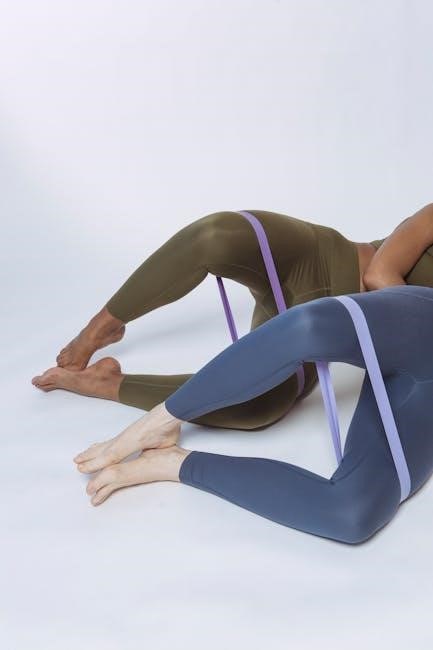
Calisthenics is a form of exercise using body weight for strength, flexibility, and coordination. It’s cost-effective, requires no equipment, and is accessible to all fitness levels.
1.1 What is Calisthenics?
Calisthenics is a form of exercise that uses body weight as resistance to develop strength, flexibility, and coordination. It involves movements like push-ups, squats, and lunges that engage multiple muscle groups. Unlike weightlifting, calisthenics relies on natural movements, making it accessible to people of all fitness levels. It requires minimal to no equipment, making it a cost-effective and convenient way to stay fit. Calisthenics exercises can be performed anywhere, from home to outdoor spaces, and are ideal for those seeking a holistic approach to physical fitness. This method of training enhances overall athleticism and promotes mental discipline, making it a popular choice for many.
1.2 Benefits of Calisthenics
Calisthenics offers numerous benefits, including improved strength, endurance, and flexibility. It enhances overall physical fitness by engaging multiple muscle groups simultaneously. Bodyweight exercises like push-ups and squats are effective for building muscle and burning calories, making calisthenics ideal for weight loss. Its low-cost nature and lack of equipment requirements make it accessible to everyone. Regular practice boosts coordination and mental discipline. Calisthenics also improves posture and reduces injury risk by strengthening core muscles. With its versatility, it suits all fitness levels, from beginners to advanced athletes. Incorporating calisthenics into your routine promotes a balanced and sustainable approach to overall well-being.
1.3 Why Choose Calisthenics?
Calisthenics is a highly effective and versatile workout method that requires minimal equipment, making it accessible anywhere. It improves strength, flexibility, and cardiovascular health simultaneously. Unlike traditional gym routines, calisthenics focuses on functional movements that enhance daily activities. It’s cost-efficient, eliminating the need for expensive gym memberships or equipment. The scalability of exercises, from basic push-ups to advanced moves like handstand push-ups, caters to all fitness levels. Additionally, calisthenics builds mental discipline and resilience, fostering a strong mind-body connection. Its portability and efficiency make it ideal for busy individuals seeking a comprehensive workout. This holistic approach to fitness makes calisthenics a preferred choice for many.
Calisthenics Exercises for Beginners
Beginners can start with basic push-ups, squats, planks, and lunges. These exercises build strength, endurance, and flexibility without equipment, forming a solid foundation for progress.
2.1 Basic Push-Ups
Basic push-ups are a fundamental calisthenics exercise that targets the chest, shoulders, and triceps. Start in a plank position with hands shoulder-width apart, engage your core, and lower your body until your chest nearly touches the ground. Push back up to the starting position. Proper form is crucial to avoid injury and maximize effectiveness. Variations like knee push-ups can be used by beginners to build strength gradually. Incorporate push-ups into your routine to improve upper body strength and overall fitness. They are simple yet effective for building a strong foundation in calisthenics training.
2.2 Bodyweight Squats
Bodyweight squats are a foundational calisthenics exercise that works multiple muscle groups, including the quadriceps, hamstrings, and glutes. Stand with feet shoulder-width apart, engage your core, and lower your body until your thighs are parallel to the ground. Keep your chest up and back straight throughout the movement. This exercise improves strength, flexibility, and balance. For beginners, bodyweight squats are an excellent starting point before progressing to weighted variations. They can also be modified, such as using a chair for support, to suit different fitness levels. Regular practice enhances lower body strength and overall athletic performance.
2.3 Plank Hold
The plank hold is a fundamental calisthenics exercise that targets the core muscles, including the abdominals, obliques, and lower back. To perform a plank, start in a push-up position with your hands shoulder-width apart, arms straight, and legs extended. Engage your core, keep your body in a straight line from head to heels, and hold the position for as long as possible. Proper form is crucial to avoid strain and maximize effectiveness. Beginners can start with shorter durations and gradually increase the hold time. The plank improves posture, stability, and overall core strength, making it an essential part of any calisthenics routine.
2.4 Lunges
Lunges are a versatile calisthenics exercise that target the lower body, including the quadriceps, hamstrings, and glutes. They improve balance, strength, and functional movement. To perform a lunge, stand tall, take a large step forward, and lower your body until both knees are bent at 90 degrees. Keep your back straight, front knee over your ankle, and rear knee nearly touching the ground. Push through your front heel to return to the starting position. Alternate legs with each repetition. Lunges enhance coordination and stability while building powerful legs. Proper form is essential to prevent injury and maximize results. Incorporate lunges into your routine for a strong, balanced lower body.

Advanced Calisthenics Exercises
Advanced calisthenics exercises push your limits, enhancing strength and endurance. Techniques like handstand push-ups, pistol squats, and muscle-ups challenge your body. Incorporate HIIT for weight loss and superior fitness.
3.1 Handstand Push-Ups
Handstand push-ups are an advanced calisthenics exercise that targets the shoulders, triceps, and upper body. Perform by kicking into a handstand against a wall, then lowering and pushing back up. Engage your core for stability. Start with wall-assisted variations and progress to freestanding as strength improves. This exercise builds explosive power and endurance. Focus on slow, controlled movements to maintain proper form and prevent injury. Incorporate handstand push-ups into your routine for a challenging upper body workout that enhances overall strength and coordination. They are a key component of advanced calisthenics training, offering significant benefits for muscle development and functional fitness.
3.2 Pistol Squats
Pistol squats are a challenging single-leg exercise that enhances balance, strength, and flexibility. Start by standing on one leg, lowering your body until your thigh is parallel to the ground, then push back up. This movement targets the quadriceps, hamstrings, and glutes. Proper form is crucial to avoid injury, so focus on maintaining a straight back and controlled descent. Beginners can use a chair or bench for support during the squat. Pistol squats improve unilateral strength and coordination, making them a valuable addition to advanced calisthenics routines. Incorporate them into your workout to build powerful, balanced legs and enhance overall lower body stability.
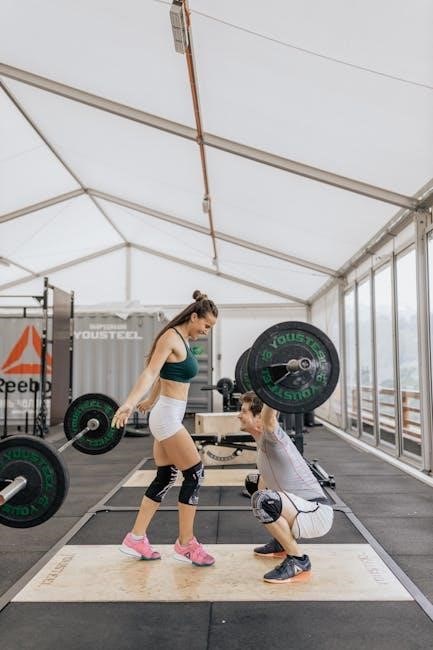
3.4 Muscle-Ups
Muscle-ups are an advanced calisthenics exercise that combines a pull-up and a dip, engaging the entire upper body. They require significant strength, control, and technique. Start with a dead hang on a bar, pull yourself up until your chest clears the bar, then transition into a dip, lowering and pushing back up. Muscle-ups target the lats, shoulders, and triceps, building powerful upper body strength. For beginners, mastering pull-ups and dips separately is essential before attempting a muscle-up. Variations include weighted or slow-tempo muscle-ups for added challenge. This exercise is a testament to calisthenics’ ability to build functional, impressive strength without equipment.
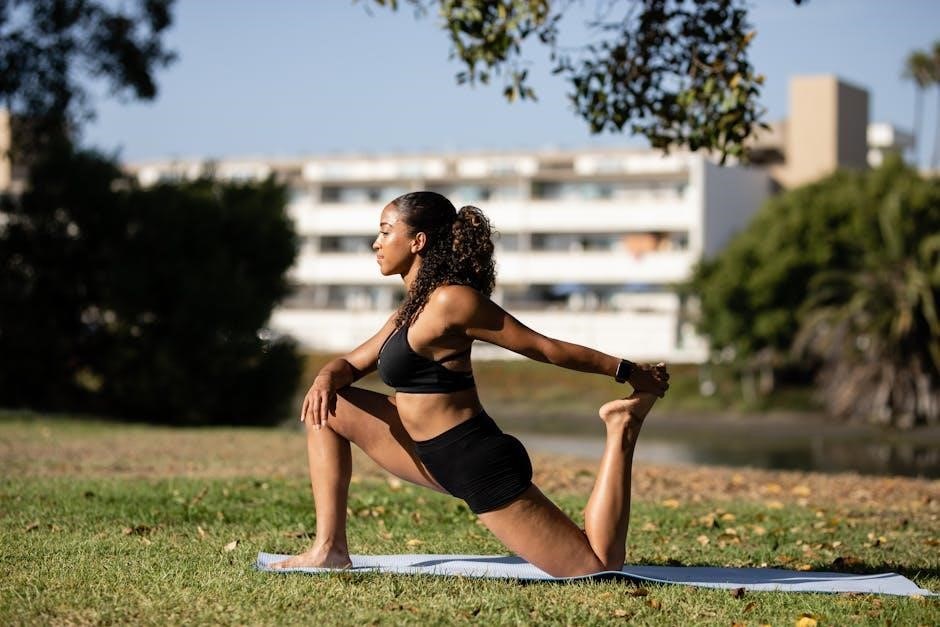
Calisthenics Workout Plan
A well-structured calisthenics workout plan includes full-body circuits, upper body focus, lower body emphasis, and core strength training. It enhances strength, flexibility, coordination, and burns calories effectively.
4.1 Full-Body Circuit Routine
A full-body calisthenics circuit routine engages all major muscle groups, improving overall strength and endurance. It typically consists of 3-4 circuits with 8-10 exercises, such as push-ups, squats, lunges, and planks. Each exercise is performed for 30-60 seconds, with short breaks between sets. This routine boosts cardiovascular fitness, burns calories, and enhances flexibility. It’s ideal for those seeking a balanced workout without equipment. Beginners can start with 2 circuits, gradually increasing intensity. Advanced individuals can add complex moves like handstand push-ups or muscle-ups. Proper form and warm-up are essential to avoid injury and maximize results. This approach ensures a comprehensive and efficient training session.
4.2 Upper Body Focus
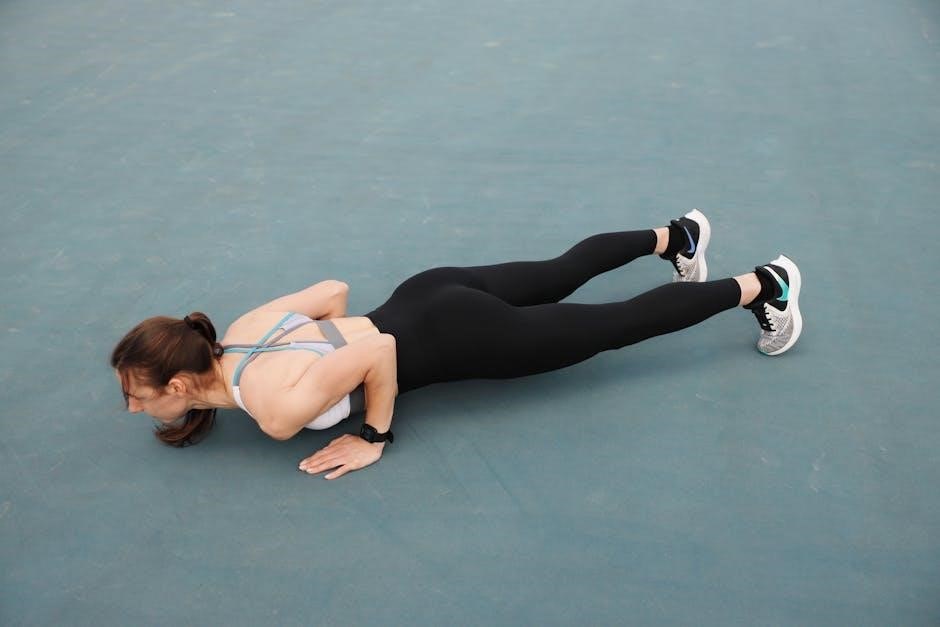
An upper body-focused calisthenics routine targets muscles like the chest, shoulders, and arms. Exercises include push-ups, pull-ups, dips, and handstand push-ups. Push-ups build chest and tricep strength, while pull-ups enhance lat and shoulder development. Dips improve tricep and chest definition, and handstand push-ups challenge shoulder stability and strength. For progression, reduce rest between sets or increase reps. Incorporating variations, like wide-grip pull-ups or decline push-ups, can target specific muscle groups. This routine is ideal for building a strong, defined upper body without weights. Consistency and proper form are key to achieving visible results and avoiding injury.
4.3 Lower Body Focus
A lower body-focused calisthenics routine targets muscles like the legs, glutes, and calves; Squats and lunges are foundational exercises that build strength and definition in the thighs and glutes. Glute bridges and calf raises are excellent for isolating the glutes and lower legs. For progression, increase reps or add variations like sumo squats or step-ups. These exercises improve balance, coordination, and overall lower body strength. Incorporating plyometric movements, such as jump squats, can enhance power and explosiveness. Consistency in this routine helps develop a strong, athletic lower body without the need for weights or equipment.
4;4 Core Strength Training
Core strength training is essential for stability, balance, and overall athletic performance. Planks, Russian twists, and leg raises are fundamental exercises that target the abdominals and obliques. Incorporate variations like side planks and bicycle crunches for a well-rounded core workout. Superman holds and bird dogs can strengthen the lower back and improve posture. For advanced trainees, dynamic exercises like flutter kicks and hanging leg raises challenge stability and endurance. Consistency in core training enhances functional movement and reduces injury risk. A strong core is the foundation of any effective calisthenics routine, providing the stability needed for advanced movements and ensuring proper form during exercises.
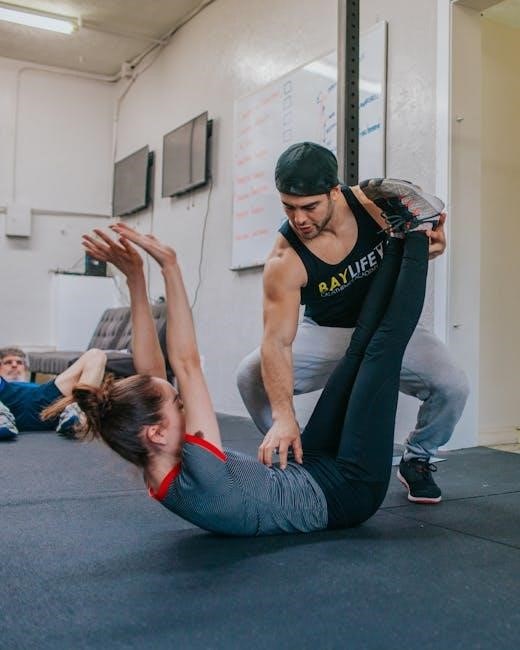
Calisthenics for Weight Loss
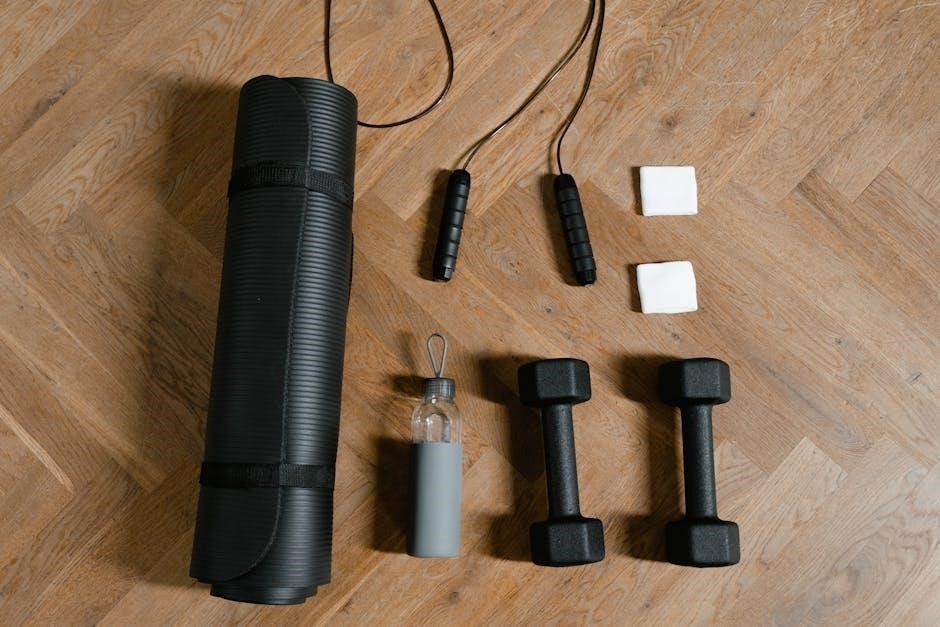
Calisthenics is highly effective for weight loss, burning calories and boosting metabolism. Bodyweight exercises like push-ups, squats, and lunges efficiently target fat loss while building lean muscle.
5.1 Calorie Burn and Fat Loss
Calisthenics is a powerful tool for calorie burn and fat loss, engaging multiple muscle groups simultaneously. High-intensity exercises like push-ups, squats, and lunges accelerate metabolism, promoting sustained calorie burn. These bodyweight movements enhance cardiovascular health and improve muscular endurance, making them ideal for weight loss. Consistency is key, as regular calisthenics workouts create a calorie deficit, essential for shedding fat. Incorporating strength training and HIIT (High-Intensity Interval Training) further maximizes fat loss. Calisthenics offers a practical, equipment-free approach to achieving a lean, toned physique, making it an excellent choice for those seeking sustainable weight management and overall fitness improvement.
5.2 High-Intensity Interval Training (HIIT)
High-Intensity Interval Training (HIIT) combines short bursts of intense calisthenics exercises with brief rest periods, maximizing fat loss and improving cardiovascular health. This method boosts metabolism, promoting prolonged calorie burn post-workout. HIIT sessions, such as 30 seconds of rapid push-ups followed by 30 seconds of rest, are highly effective. They enhance muscular endurance and mental toughness. Incorporating HIIT into calisthenics routines accelerates weight loss and improves overall fitness. Its efficiency and adaptability make HIIT a cornerstone of modern calisthenics training, suitable for all fitness levels seeking optimal results in minimal time.

Calisthenics Safety and Tips
Calisthenics requires proper warm-ups, focusing on form to prevent injuries. Avoid overexertion and consult professionals for personalized routines and safety guidance.
6.1 Warm-Up and Cool-Down
A proper warm-up is essential for calisthenics to prevent muscle strain and improve circulation. Start with light cardio like jogging or jumping jacks, followed by dynamic stretches targeting major muscle groups. This prepares the body for physical activity and enhances flexibility. After the workout, a cool-down with static stretches helps relax muscles, reducing soreness and improving recovery. Incorporate deep breathing exercises to lower heart rate and promote relaxation. A well-structured warm-up and cool-down routine ensures safety, optimizes performance, and supports overall fitness goals. Consistency in these practices is key to avoiding injuries and maintaining long-term progress in calisthenics training.
6.2 Form and Technique
Maintaining proper form and technique is crucial in calisthenics to maximize effectiveness and minimize injury risk. Focus on engaging the correct muscle groups and avoiding unnecessary strain. Common mistakes include rushing through movements or sacrificing form for repetitions. Prioritize controlled, slow executions to build strength and stability. For exercises like push-ups, ensure a straight line from head to heels and lower until the chest nearly touches the ground. In squats, keep the chest upright and knees over toes. Practicing in front of a mirror or filming workouts can help identify and correct poor form. Mastering technique lays the foundation for advanced movements and long-term progress in calisthenics training.
6.3 Avoiding Injury
Avoiding injury in calisthenics requires mindfulness and adherence to proper practices. Always listen to your body and stop if pain occurs. Poor form or overexertion can lead to strains or long-term damage. Ensure adequate rest between workouts to prevent overtraining. Gradually increase intensity and volume to allow muscles and joints to adapt. Warm-up and cool-down routines are essential for preparing and recovering. Focus on controlled movements and avoid sacrificing form for speed or repetitions. Strengthening core and stabilizer muscles also enhances injury resilience. Consulting a professional or following a structured calisthenics PDF guide can provide personalized tips for safe training.

Calisthenics PDF Guide

A downloadable calisthenics PDF guide offers structured workout plans, exercise tutorials, and tips for all fitness levels. It helps users achieve their goals without expensive equipment.
7.1 Downloadable Workout Plans
Downloadable calisthenics workout plans are designed for both beginners and advanced users, offering structured routines to build strength, balance, and flexibility. These PDF guides provide detailed exercises, sets, and reps, ensuring progress. Beginner plans often include a 6-month program with gradual intensity increases, while advanced plans focus on complex movements like handstands and muscle-ups. Many plans are accompanied by nutritional advice and motivation tips to keep users consistent. With options for full-body circuits or targeted workouts, these plans cater to diverse fitness goals. Whether aiming for weight loss or muscle gain, downloadable PDFs offer a clear, organized path to achieving results without gym equipment.
7.2 Exercise Manuals and Tutorials
Exercise manuals and tutorials in calisthenics PDF guides provide step-by-step instructions for mastering bodyweight movements. These resources often include detailed descriptions, photos, and diagrams to ensure proper form and technique. Beginners can learn foundational exercises like push-ups, squats, and planks, while advanced athletes can refine skills like handstand push-ups and muscle-ups. Many manuals also offer progression plans, allowing users to gradually increase difficulty as they build strength and confidence. Additionally, tutorials may cover common mistakes to avoid and tips for improving flexibility and mobility. These comprehensive guides are essential for anyone looking to enhance their calisthenics practice and achieve their fitness goals effectively.